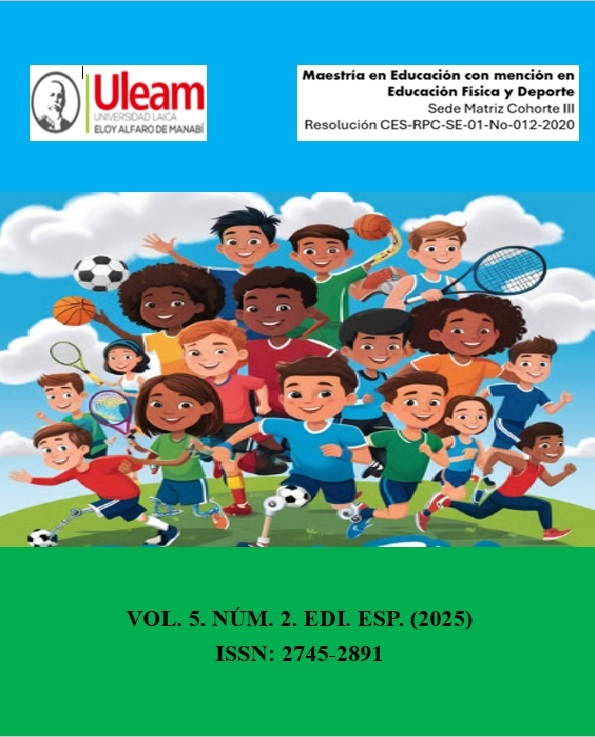Recreational yoga sessions to improve balance in high school children
Abstract
Balance is a fundamental skill in children's motor development, especially during the preparatory stage, as it enables the safe performance of physical activities and promotes proper body posture. However, the rise in childhood sedentary behavior and the limited inclusion of playful strategies in the curriculum have contributed to the deterioration of this ability. In this context, recreational yoga emerges as an innovative pedagogical tool capable of integrating movement, attention, and emotional self-regulation from an early age. This study was based on a literature review of indexed scientific research and interviews with two teachers, aiming to analyze the impact of recreational yoga on balance in preparatory education children. The findings show that yoga programs lasting at least eight weeks with a frequency of two to three sessions per week lead to significant improvements in standardized tests such as the BOT-2 and the Flamingo Test. In addition, the interviewed teachers reported progress in body stability, postural alignment, and motor confidence in children. It is concluded that recreational yoga represents an effective, accessible, and pedagogically viable strategy to promote integral development and body awareness in early education.
Downloads
References
Bagkur M., Gunay E.,Yerlikaya T. y Oniz A. (2024). Impact of Yoga Intervention on Physical Fitness Parameters in Preadolescent Children: A Randomized Controlled Trial. J Basic Clin Health Sci. 8, 651-659. https://dergipark.org.tr/tr/download/article-file/3961812#:~:text=FLL%28M1%29%2012,2%200.107
Berger D., Silver E. y Stein R. (2009). Effects of yoga on inner-city children's well-being: a pilot study. Altern Ther Health Med. 15(5), 36-42. https://pubmed.ncbi.nlm.nih.gov/19771929/#:~:text=Results%3A%20%20Data%20were%20collected,strength%2C%20flexibility%2C%20balance
Campoverde, L., Escobar, J., Herrera, A., y Villamar, M. (2025) Estrategias para Fomentar la Actividad Física en Adolescentes: Un Enfoque para Reducir el Sedentarismo en Ecuador. Reincisol, 4(7), 1283- 1306. https://doi.org/10.59282/reincisol.V4(7)1283-1306
Donahoe-Fillmore B. y Grant E. (2019). The effects of yoga practice on balance, strength, coordination and flexibility in healthy children aged 10-12 years. J Bodyw Mov Ther. 23(4), 708-712. https://dx.doi.org/10.1016/j.jbmt.2019.02.007.
Fernández, G., & Mejía, K. (2020). El yoga para desarrollar el esquema corporal en niñas y niños de 4 a 5 años. [Tesis de pregrado, Universidad Central del Ecuador]. https://www.dspace.uce.edu.ec/server/api/core/bitstreams/7fb8800b-17f4-4e71-9a81-08fffb60f353/content
Galantino M., Galbavy R. y Quinn L. (2008). Therapeutic effects of yoga for children: a systematic review of the literature. Pediatr Phys Ther. 20(1), 66-80. https://dx.doi.org/10.1097/PEP.0b013e31815f1208
Jarraya S., Jarraya M. y Nouira S. (2022). Effect of Yoga on Motor Skills and Self-Esteem in Kindergarten Children: A Randomized Controlled Trial. Int J Yoga Therap. 1(32) https://doi.org/10.17761/2022-D-21-00060
Jeter P., Nkodo A., Moonaz S. y Dagnelie G. (2014). A systematic review of yoga for balance in a healthy population. J Altern Complement Med. 20(4), 221-32. https://dx.doi.org/10.1089/acm.2013.0378
Khalsa, S. y Butzer, B. (2016). Yoga in school settings: a research review. Ann N Y Acad Sci, 1373(1), 45-55, https://doi.org/10.1111/nyas.13025
Olarte, P., Noguera, L. y Herazo, Y. (2022). Nivel de actividad física, comportamiento sedentario y sueño en la población de la primera infancia. Nutrición hospitalaria, 38(6), https://dx.doi.org/10.20960/nh.03488
OMS. (26 de Junio de 2024). Organización Mundial de la Salud. Obtenido de Actividad física: https://www.who.int/es/news-room/factsheets/detail/physical-activity
OMS. (2025). Actividad física. https://www.who.int/initiatives/behealthy/physical-activity#:~:text=Children%20and%20adolescents%20aged%205,years
Otañez, P., Villamarin, L. & Constante, M. (2024). El Yoga Infantil como Herramienta para la Psicomotricidad en Educación Infantil. Tesla Revista Científica, 4(1), https://doi.org/10.55204/trc.v4i1.e336
Sutapa P., Pratama K., Rosly M., Ali S. y Karakauki M. (2021). Improving Motor Skills in Early Childhood through Goal-Oriented Play Activity. Children (Basel). 2(11). https://doi.org/10.3390/children8
Telles, S., Singh, N. y Bhardwaj, A. (2013). Efecto del yoga o el ejercicio físico en las medidas físicas, cognitivas y emocionales de niños: un ensayo controlado aleatorizado. Child Adolesc Psychiatry Ment Health. 7(37) https://doi.org/10.1186/1753-2000-7-37
Veldman, S., Jones, R., Chandler, P., Robinson, L. y Okely, A. (2019). Prevalence and risk factors of gross motor delay in pre-schoolers. Journal of Paediatries and Child Health, 56(4), 571-576. https://doi.org/10.1111/jpc.14684.
Veljkovic, A., Katanic, B. Masanovic, B. (2021). Effects of a 12-Weeks Yoga Intervention on Motor and Cognitive Abilities of Preschool Children. Front Pediatr. 26(9). https://dx.doi.org/10.3389/fped.2021.799226
Wolff, K. y Stapp, A. (2019). Investigating Early childhood teachers’ perceptions of a preschool Yoga program. SAGE Open, 9(1). https://doi.org/10.1177/2158244018821758
Copyright (c) 2025 Winniffer Lisbeth Macías Cedeño,Giorver Pérez

This work is licensed under a Creative Commons Attribution-NonCommercial-NoDerivatives 4.0 International License.






